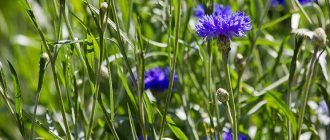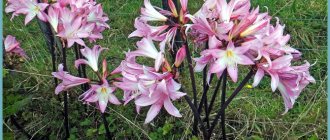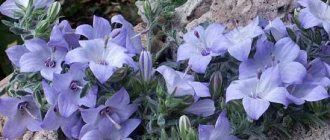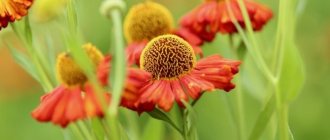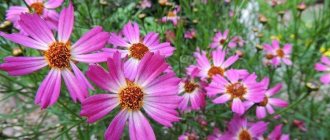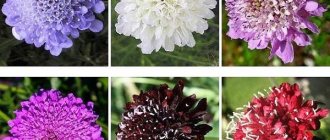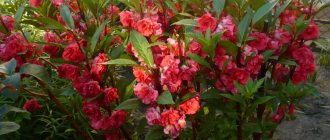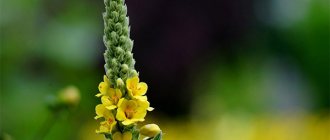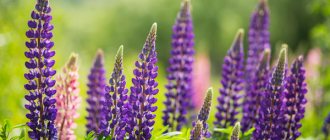Colorful symbols of summer, reverent, tender, and at the same time so hardy, decorative poppies do not leave anyone indifferent. The inimitable colors and structural details of these amazing flowers are an invariable decoration of any summer garden. But growing decorative poppies is not a completely standard task, although it is not difficult. Poppies are propagated by seeds, and the available choice of sowing methods and methods allows everyone to find their own ideal option.
Alpine poppy (Papaver alpinum). © HermannSchachner
The reputation of cultivated, ornamental poppies has suffered significantly from confusion and their association with a species whose cultivation is punishable by law - the soporific poppy. The most beautiful ornamental poppy, the oriental poppy, which, if it can be grown, is limited to a few copies, as well as several other species, also suffered from the legislative ban. But other types of poppies, which have nothing to do with opiates and do not contain narcotic substances - beautifully flowering annuals, biennials and perennials - for some reason also remain a banned plant for many. And although there are no fewer admirers of the beauty of poppies, they are still significantly inferior in their distribution to other summer-blooming competitors.
Note! According to the current legislation of the Russian Federation, the cultivation of the following types of poppies is prohibited: soporific, oriental, bristlecone, bract.
Description of poppy
Members of the genus Poppy (Papaver) are herbaceous perennials, biennials and annuals with very powerful taproots, strong, straight single shoots, and amazing heavily haired carved greenery, famous for its filigree silver-blue texture. Alternately arranged, pinnately dissected, almost prickly to the touch due to the edge, the leaves can reach 30 cm in length.
The poppy blossom is a fascinating sight. Drooping buds, straightening peduncles as they bloom and spectacular large saucer flowers with the most beautiful stamens among garden plants are mesmerizing. The calyx of the flower consists of two large sepals, and the corolla is easily recognized by its delicate, almost transparent, tremulous four large petals surrounding a delightful “powdered” center of anthers and stamens, usually almost black in color.
Red, yellow, pink, orange, violet and even blue - decorative poppies boast amazingly beautiful shades that inspired legendary painters and today cause only admiration. After flowering, fruit boxes with beautiful discs at the top, filled with small rounded seeds of different shades of gray, are set.
Without exception, all poppies are propagated by seeds. And annuals - peony poppy, tangled poppy or changeable poppy are now classified as self-seeded poppy, glaucous poppy, bare-stemmed poppy or saffron poppy, peacock poppy; and more durable poppies - Alpine poppy, Amur poppy, Atlantic poppy, Burcera poppy, Lapland poppy, Miyabe poppy, polar or Scandinavian poppy, grayish or Tien Shan poppy, Tatra poppy - are best propagated by seeds. Some vegetative methods are also used only for perennial species. Growing poppies from seeds is very easy, as the plant often blooms within two months of germination.
Terry and peony poppy. © thompson-morgan
What species can and cannot be grown?
Both perennial and annual poppies are cultivated in horticulture. © https://ydoo.info/qa/kak-vyrashchivat-maki.htmlHowever, you need to know exactly which types and varieties of plants are legally allowed to be grown in Russia and which are not.
Varieties of decorative poppy that can be grown in the garden:
- holostem;
- changed;
- peacock;
- peony-shaped;
- self-seeding
How many poppy bushes are allowed to grow? The number should not exceed 10 bushes in one area.
It is prohibited to grow varieties on the site that include psychotropic and narcotic substances:
- Oriental;
- bract;
- sleeping pills (also called opium poppy);
- bristle-bearing.
It is also not allowed to grow flowers that have too large boxes. And some argue that no varieties of the plant should be grown at all, since they contain opium in any case.
Among the annuals that can be grown in the garden, the most famous are:
- Holostem poppy (also called saffron poppy) (see photo). Although it is a perennial, it is grown as an annual herbaceous plant. Bred in Mongolia, Eastern Siberia, Central Asia and Altai. The length of the stem reaches thirty centimeters. The foliage is basal, greenish or grayish in color, pinnate, and can be either bare or hairy. The flowers are whitish, orange or yellowish in color, mounted on strong pedicels, the length of which varies within twenty centimeters. It blooms in May and ends blooming in October. The culture is considered poisonous. Plant varieties - “roseum”, “popskyle”, “atlant”.
- Samoseed poppy. It is characterized by erect branching or spreading stems reaching sixty centimeters in length. The basal leaves are quite large and have teeth along the rim, and the stem foliage is tripartite and has pinnately dissected lobes. The leaves and stem of the plant are covered with stiff hairs. The petals are pinkish, reddish or whitish. In the garden or on a summer cottage, such varieties of self-seeding as “silk moire” and “Shirley” are grown.
Among perennials, oriental poppy is widely in demand. A herbaceous crop with an even and strong stem, which is covered with bristly hairs, reaches 1 meter in height. The flowers are painted in a rich red hue, with a dark spot closer to the base. Flowering continues for a couple of weeks. Bees love this plant very much. Varieties of oriental poppy - “Allegro”, “Beauty Queen”, “Cedric Morris”. However, this type of crop is not allowed to be grown in the garden.
Where are edible (confectionery) poppies grown? Flowers grow in protected fields under license for the food industry.
Strategies for growing poppies from seeds
Poppies are one of those herbaceous plants that respond very poorly to transplantation. If possible, they should always be sown directly at the growing site. Poppies are grown very rarely from seedlings, usually only when the plants are going to be used as potted or container accents.
Conditions for growing poppies
Poppies, regardless of type, are light-loving plants, but perennial species can withstand light shading. Poppies, in theory, are not afraid of even windy areas, but if you do not protect the plant from drafts, its beautiful flowers will quickly fall off. By choosing secluded, warm, protected areas, you will prolong the pleasure of watching the magnificent poppies bloom. The soil for poppies can be chosen from any of the cultivated and non-damp soils, but the best flowering is always observed on nutritious soil. There is a place for poppies in mixed gardens, flower beds, rock gardens or rock gardens, and on the lawn.
When choosing a place for poppies in your garden, it is worth remembering that the flowering of this plant is very short: within a month after its start, the fruits ripen, and then the plant quickly leaves the garden scene. Even the best perennial poppies have a growing season limited to an average of 100 days. Therefore, poppies need to be planted so that neighboring plants can disguise the unattractive fading and then disappearing greenery, or provide for the planting of other seasonal annual stars in place of poppies. The best partners for perennial poppies are delphiniums, cereals, cornflowers, yarrow, asters, speedwells, oregano and cornflowers.
Hollow poppy (Papaver nudicaule). © 99roots
Diseases and pests
- The main problem for poppies is fungal diseases. The most common fungal diseases of poppies are powdery mildew, downy mildew and fusarium. With powdery mildew, the leaves become covered with a white coating, similar to a cobweb. After it disappears, you can notice the bodies of the fungi in the form of black small spots. Powdery mildew significantly inhibits plant growth and prevents the formation of flowers and fruits.
- The fight against it is carried out by spraying poppy leaves with solutions of the following compositions: 40 g of copper chloroxide in 10 liters of water or 50 g of soda in 10 liters of water. With peronosporosis, the leaves become covered with spots of a red-brown hue and are significantly deformed. In addition, curvature of the stems and peduncles occurs. At the next stage of infection, fungal bodies appear on the leaves in the form of purple spots. At the same time, the plant’s growth slows down, and the size of flowers and fruit pods decreases significantly.
- Fusarium is the most unpleasant poppy disease. With it, the leaves turn black, and the entire bush begins to dry out, since the entire vascular system of the plant is affected. It is impossible to cure this disease, so the infected plant must be immediately removed and destroyed, and the place where it grew should be treated with some kind of fungicide. There are relatively few pests that can attack poppy. Most often, plants are attacked by weevils or poppy secretive proboscis. Both pests in adult form damage the root system of the plant, and the larvae of the secretive proboscis also feed on its leaves.
- Pest control consists of preventive treatment of the soil before planting with Bazudin or Chlorophos. Application rates are usually indicated on the packaging of the drugs. If pests are found on plants, they should be treated three times with Chlorophos solution. The break between treatments is 10 days. When processing, do not allow the insecticide to come into contact with poppy flowers and fruits.
Growing perennial and biennial poppies
Sowing seeds of perennial and biennial poppies is similar and not complicated. These poppies are grown:
- sowing in early spring;
- sowing before winter.
The latter option is considered preferable, since the plants are stronger and more powerful, develop better and bloom earlier. When sowing in spring, young plants will need more careful care, because while the seedlings are getting stronger, they will already face heat and drought and will not be able to develop normally without watering.
Perennial or biennial poppies can be sown in seedling beds, diving after the appearance of the first or second true leaf to a permanent place, but it is better to sow them immediately at the place of cultivation.
During pre-winter planting, the sowing of poppies is delayed until the last minute so that the seeds, which germinate quickly enough even in cold soil, do not wake up before the beginning of winter. Even a soil temperature of 3-5 degrees is not suitable: poppy is sown when the soil has time to freeze in the top layer, that is, most often in November.
In the spring, planting is carried out when the weather permits, the snow has melted and the soil has at least slightly thawed.
The technique for sowing poppy seeds remains the same regardless of the timing of their sowing:
- The soil is prepared in advance or before planting by digging and loosening the soil. When cultivating the soil, it is necessary to remove weed rhizomes, apply organic fertilizers and a complete mineral mixture (about 10 kg of organic matter, compost or humus and 40-50 g of mineral fertilizers per square meter of soil).
- At the sowing site in the fall, shallow grooves or rows are carefully created, only up to 2–3 cm deep. Spring sowing can be carried out both in furrows and superficially.
- Poppy seeds are placed at a considerable distance from each other (from 5 to 20 cm) so that the plants do not need to be thinned.
- The winter crops are covered with soil from above, making sure that they do not go too deep. When sowing in spring, the seeds are not covered or covered with a light layer of soil or film to speed up germination and the procedure is completed with watering.
- After spring sowing, you need to maintain stable soil moisture for 2 weeks and make sure to remove the film immediately when seedlings appear.
Seeds sown in the fall will germinate in the spring, as soon as the soil warms up to 3-5 degrees; spring sowing can be expected in 10-20 days. Even young plants are frost-resistant, but if frost exceeds 5 degrees below zero, then it is better to additionally protect spring crops with non-woven materials.
If sowing was carried out densely, then the seedlings are thinned out twice - first at a distance of 10 cm between plants, and then at a distance of 20 cm.
Perennial poppy seedlings. © directplant
Planting and care
The plant is very undemanding to care and maintenance. Peony poppy can be compared to an ordinary weed that can grow on its own. But if you give the plant at least a minimum of care, it will definitely reward you with long-lasting lush and bright flowering.
Selecting a location
In the garden, a bright area should be allocated for terry poppy. The flower loves the sun very much, but a little partial shade is allowed. It is not worth planting in shady places, the plant will grow and develop poorly, and flowering in an unlit area may not occur at all.
Poppy is completely undemanding to the mechanical composition of the soil. Grows well in light sandy, loose soils. It is better not to grow the plant on clay and loamy soils.
Waterlogging of the soil is the main reason for the death of the bush. Peony poppy does not tolerate stagnation of water in the soil; this feature must be taken into account when planning a planting site.
It is recommended to plant the flower on a small hill or provide a drainage layer and provide for the possibility of draining excess water.
Watering
The plant is drought-resistant; a long absence of watering or natural precipitation will not affect the well-being of the flower. The long tap root is able to provide the poppy with the necessary moisture throughout the entire growth period. But, despite this ability of the plant, moderate periodic watering should be provided. The plant mainly needs watering only during flowering.
Fertilizer
Peony poppy can do without any fertilizing. However, to obtain bright and larger flowers and rich leaf color, the poppy bush is fed twice a year with liquid mineral or organic fertilizers for garden flowering plants. Fertilizer is applied in the spring when digging the soil, preparing a place for planting a flower. After removing the faded plant, the soil is re-fertilized before planting the seeds in the fall.
Transfer
Peony poppy does not tolerate transplants. This is all because of the tap root, which is difficult to remove from the ground without damaging it. Many are of the opinion that replanting is possible only in cases of extreme necessity, for example, when the plant is in danger of dying. However, this procedure is extremely painful for the papaver: the bush may stop growing, stop blooming, or even die. Since peony poppy is an annual plant, there is no point in replanting it. It’s easier to remove the bush and then replant the poppy.
Trimming
Terry papaver is great for cutting and is often used in floristry. A barely opened bud is cut from a bush. To stimulate the formation of new buds, old faded flowers should be removed from the bush. To obtain seed material, 1–2 boxes are left on the bush.
Wintering
Peony poppy, being an annual plant, largely loses its decorative appearance after flowering. In autumn, the bush is completely cut off at the root and the soil is dug up. Old bushes do not need to be removed; they will become good mulch.
Caring for young poppies
Poppies are drought-resistant, hardy and generally unpretentious plants. One point of care is very important for young seedlings, and even adult poppies - timely weeding, since poppies will not be able to compete with other aggressive plants.
If sowing was carried out in the spring, then until the plants become stronger, they need to be protected from drought. Both fall-sown and adult poppies in the active growing season respond well to additional watering, but the main thing with moisture is not to overdo it, just providing protection from drought. If the plants are very tall or the site is windy, then it is better to tie the stems to supports as they grow.
There is no need to cover young poppies during the first winter.
Decorative poppies also require other aspects of care:
- loosening the soil;
- feeding (at least one spring or 2-3 feedings per season)
Young poppy bush. ©Jason
Sowing time
Poppy seeds must be cold-treated before germination. Therefore, there are two temporary options when you can sow poppy seeds in open ground:
- in cold soil - at the end of autumn or at the end of winter;
- into warmed ground - in March-April (preliminary “hardening” will be required, described in more detail below).
As for choosing a planting site, it should definitely be in the sun: poppies do not bloom well in the shade. This plant loves light, fertile and well-drained soil. Either black soil or sandy loam soil is suitable for it.
Alternative methods for propagating poppies
All poppies, both annual and perennial, self-sow, and this ability can be used for “improvisation”, creating natural accents and unexpected flowering spots. If you don’t want poppies to appear in unexpected places and “migrate” around the garden, or you simply want to limit the amount of self-seeding in annual poppies that are very generous in this regard, then you need to remove the seed pods before they ripen and scatter the seeds, which scatter amazingly easily from the holes under the disc at the top of the fruit.
You can often see information that poppies are divided and rejuvenated, and for perennial species it is even recommended to dig up and divide plants once every 3 years. But replanting poppies is very poorly tolerated and can only be done in exceptional cases when the plants are in danger of dying. This is not about true separation, but about the separation of lateral rosettes and shoots that appear not only in spring, but also at the end of summer. Such babies take a very long time to take root and it is difficult, but this is still an acceptable method of reproduction.
Today, more and more people are deciding to propagate poppies using green and root cuttings; root sections are found on sale along with seed packets and in botanical gardens. Root cuttings are cut from taproots, dividing them into pieces 4-5 cm long and at least 5 mm thick. After treating the cuts with crushed coal, they are dried, and then the cuttings are planted, leaving 1/3 above the soil for rooting. Under a cover, with stable humidity, the plants quickly produce tiny rosettes. After rooting and sprouts appear, the cuttings can be transplanted to a permanent location. Green cuttings are cut from lateral, weak shoots that develop on plants at the end of summer. They are rooted under a hood in a constantly moist substrate.
Possible difficulties during cultivation
Growing terry poppy is not difficult, but many may encounter problems such as:
- too wet soil: excessive constant watering can cause the plant to wither and die;
- poor soil: with a lack of nutrients in the soil, the bushes grow small and weak, the flowers are not very large and less bright;
- dense planting: the bushes are crowded, which affects the decorative appearance of the plant, they become smaller;
- poor care: if wilted flowers are not cut off in time, they will cause the appearance of seed pods. In this case, the bush completes the vegetative period and stops flowering. Trimming faded flowers prolongs the flowering period of the bush;
- the wrong place for the plant: a corner of the garden that is too dark will cause a lack of buds.
Benefits of poppy seed oil
In the 19th century, poppy seed oil was used as a “raw material” for lamps, a food product, and also a raw material for the manufacture of paints. Today this product is also widely used in the food and pharmaceutical industries, in the production of varnishes and paints. It is one of the components for the treatment of malignant tumors, hepatocellular carcinoma. As a food product, it is added to sauces, as a healthy fat, and used to make salad dressings. The advantages of this product include the fact that it is practically incapable of going rancid, and the content of opiates in it is even lower than in ripe seeds.
Beneficial properties of edible poppy
Excellent source of manganese
Manganese is a nutrient that is beneficial in preventing conditions such as weak bones, osteoporosis, inflammation, painful joints (osteoarthritis), anemia and PMS (premenstrual syndrome). Just one tablespoon of poppy seeds provides almost 30 percent of your daily manganese needs. Manganese plays an important role in the creation and activation of several enzymes. Additionally, it has antioxidant effects and may protect mitochondria while limiting oxidative stress.
Low carb and high fiber
Like other seeds such as chia and flax, poppy seeds provide fiber. Fiber is good for digestion and preventing constipation. If you're following a low-carb diet, such as a ketogenic diet, which severely limits your carbohydrate intake, then eating high-fiber foods is critical to "staying regular" and maintaining gut health. In addition to consuming fiber sources like vegetables (plus fruits, legumes and grains if you're not eating low-carb), adding seeds and nuts is an easy way to boost your overall nutrient and fiber intake.
Good source of healthy fats (Omega-6)
Poppy seeds are relatively rich in linoleic acid, a type of omega-6 fatty acid. We often hear that omega-6 fats are "pro-inflammatory" and not as beneficial as omega-3s, but the truth is that we need both types of essential fatty acids. Linoleic acid is an unsaturated fatty acid found in a wide variety of plant glycosides, especially those high in oil content such as poppy seeds.
Consuming linoleic acid in moderation (this is key because very high intakes can be detrimental to health) can have a positive effect on heart health. For example, it can help lower blood cholesterol and prevent atherosclerosis. However, for greater health benefits, it is not recommended to consume large amounts of refined vegetable oils, which are very high in omega-6. Rather, we should eat a variety of whole foods that contain different types of fats (eg seeds, nuts, meat, eggs, olive oil, etc.)
Provides calcium, phosphorus and magnesium
Eating poppy seeds is a good way to get essential minerals that help maintain strong bones, including calcium, phosphorus and magnesium.
Plus, poppy seeds provide a good dose of copper, which is essential for maintaining healthy nerves, bones, and metabolism. They also contain decent amounts of zinc and iron, which are important for adrenal health, anemia prevention, skin health, and more.
Nourishes the skin
Milk and poppy seed oil are known to moisturize and heal the skin. These products may be useful in treating eczema and skin inflammation, itching, dryness, flaking and dandruff. The best way to use poppy seeds on your skin is to apply poppy oil or paste to the affected area, ideally with other beneficial ingredients such as almond oil, essential oils or honey.
The ripening season of poppy seeds and their storage conditions
This is what a field with ripe poppy fruits looks like.
Poppy seeds usually ripen closer to autumn, but it is not at all a fact that at this time you will buy a fresh harvest of this product. Most often it is sold processed and can be stored in its packaging for years.
How to choose the right poppy seeds?
Caring manufacturers of confectionery products add powdered sugar, starch, and various anti-caking agents to poppy seeds and sell them in this form. Well, in some ways it’s even convenient - you open it, pour it on the dough, wrap it all up and bake it, but on the other hand, is there anything extra in the composition of such a product? Be sure to check the information on the packaging and better buy pure poppy seeds without additives.
Pay attention to the fact that GOST R52533-2006 is indicated on the bag of poppy seeds. This is a guarantee that the seeds are free of alkaloids.
The requirements for poppy seeds are simple - they must be dry inside and out, that is, crumbly and placed in a moisture-free sealed bag. Well, of course, look at the expiration date. It is important for any product.
How to properly store poppy seeds?
After opening a package of poppy seeds, it is better to pour its contents into a container more suitable for storage - glass, tin or ceramic. It is important that such a jar or box has a lid that closes tightly.
This simple design will save your poppy from moisture, sunlight and air, which means that it can last in your kitchen for up to a year or even a little more.
Back to contents
Summarize
- Poppy seeds are rich in beneficial plant compounds and nutrients such as manganese.
- These seeds and their oil may boost fertility and aid digestion, although further research is needed on many of their purported benefits.
- Unwashed poppy seeds may also be contaminated with varying amounts of opium compounds, known for their analgesic, sedative and sleep-inducing properties.
- However, you should never eat unwashed poppy seeds due to the health risks.
- Poppy seeds sold in supermarkets or used in baked goods are considered safe and contain few, if any, opium compounds.
The article was prepared by experts for informational purposes only. It should not be used as a guide for treating medical conditions and is not a substitute for professional medical advice, diagnosis, or treatment. In case of illness or any symptoms, you should always consult a doctor and not self-medicate.
Tags: Poppy
About the author: Alexander Fedorov
Candidate of Biological Sciences, biologist, nutrition expert. Graduated from Stavropol State University with a degree in Biology at the Faculty of Biology and Chemistry.
- Related Posts
- Pine nuts: benefits and harm to the body
- Sunflower seeds: benefits and harm for women and men
- Walnuts: benefits and harm to the body
« Previous entry
Reproduction methods
Photo: https://pixabay.com/photos/poppyseed-poppy-seed-nature-opium-2557339/
The poppy flower can be propagated using seeds - this is the main method that we have already written about. Moreover, it is best not to touch annuals at all - they reproduce well by self-sowing, but the intervention of a grower in this process can give zero results.
Perennials are also propagated by cuttings and dividing the bush. It is best to take cuttings from side shoots. They take root quickly (within two weeks), but grow so slowly that you can expect flowering only after a couple of years.
A mature and vigorous plant, approximately three to five years old, can be divided into parts by cutting the rhizome. To do this, the bush is completely dug out of the ground and divided into sections. True, poppies really don’t like replanting.
Varietal plants are often sold as rhizome particles of varying sizes. After purchasing, they should be wrapped in damp moss so that the growing points remain on the surface, and stored on the bottom shelf of the refrigerator until planting. Usually shoots grow on the rhizome by this time.
Interesting facts about poppy seeds
- Confectionery poppy seeds are produced mainly in the Czech Republic and in slightly smaller quantities in Turkey. It is known throughout the world as the “Czech blue poppy.”
- The word "opium" comes from the Greek phrase "poppy juice." Well, that's quite logical.
- The Germans still have a tradition of pouring poppy seeds into the bride's wedding shoes. No, not at all so that “life doesn’t seem like raspberries” to her and it’s inconvenient to go to the altar. This is a kind of wish for numerous offspring. What do you think of it?
